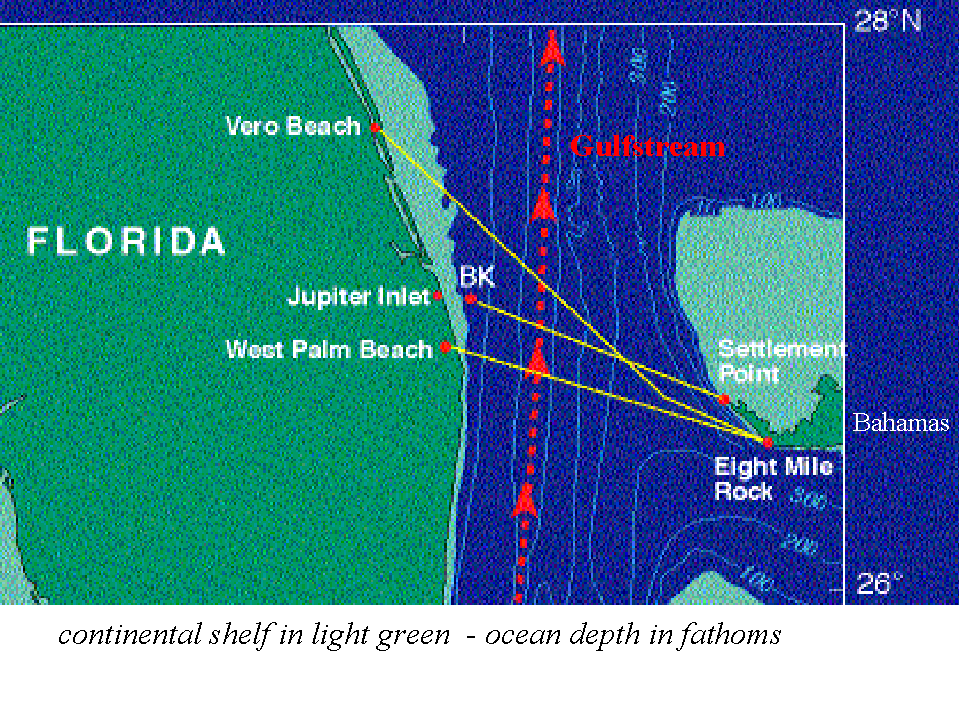Ocean transport
|
B. Geerts |
8/'98 |
![]()
Oceanographers often wish to express how much total water (or heat or salt) is transported by the currents. A transport is the total flux of whatever property through a given area. The general expression for the transport or flux (F) of a property is the integral of the property (P) times velocity (v) over the area (dA). The area is a cross section, i.e. the width of the current times its depth.
F = ò P*v dA
The following flux types are most commonly used:
Volume flux: the integral of velocity over the area (here P=1). Units are m3/sec. A typical flux for a major surface current is on the order of 10 to 100 million m3/sec. The unit Sverdrup (Sv) is widely used, after the Scandinavian meteorologist/oceanographer Harald Ulrik Sverdrup (1888-1957). One Sv = 1 x 106 m3/sec.
Mass flux: integral of density*velocity over the area (here P=r w, where r w is roughly 1000 kg/m3). Units are kg/sec. A typical flux for a major current is order 10 to 100 x 109 kg/sec.
Heat flux: integral of heat*velocity over the area (here P=r w*C w*T, where T is the temperature in degrees Kelvin, and C w is the specific heat of water, i.e. C w = 4218 J/(kg.K)). Units are Watts (Joules/sec). The net heat flux is the difference between the heat transport out of a closed volume and that into that volume. For instance in a region through which there is no net mass flux (i.e. the current does not accelerate nor widen), the net heat flux is proportional to the temperature difference between water entering and water leaving across the closed boundaries. In this case degrees Celsius can be used. Net heat flux across various latitude lines which close at boundaries range from -1.0 to 1.0 x 1015 W, or from -1 to 1 PW (petawatts).
Salt flux: integral of salinity*velocity over the area (here P=S, where S is the salinity, i.e. kg salt/kg seawater, typically about 3.3% or 0.033). Units are m3/sec or Sv. Salt in the ocean is not gained or lost (except over geological time scales). However freshwater is exchanged with the atmosphere and land through evaporation, rainfall, and run-off. Using the salinity measured along a section, one can calculate the salt flux across the section. Typical values are on the order 1 Sv.
For instance, the Gulf Stream, a warm western boundary current off the southeastern coast of the USA, flows at about 1 m/s, irrespective of season. Off Cape Hatteras, North Carolina, a current speed of up to 2.1 m/s has been measured (1). Between Florida and the Bahamas, an area of about 100 km wide and 500 m deep, fluxes have been estimated by means of a series of profiles on 4862 transects by ship between 1969 to 1990 (Fig 1). Through this section, the Gulf Stream moves about 32 Sv poleward, ranging from 28 to 36 Sv on a monthly-mean scale and from 20 to 43 on a daily scale (2). The mean northward heat flux is 1.30 PW (± 10%), and the salt flux is about 1.0 Sv. That is, every second about 2.5 million tonnes of salt move through this section.

Fig 1. Map of the southern tail of the Gulf Stream (called the Florida current) and transects for the flux measurements (2). One fathom equals 1.85m.
References
- Rossby, T. and E. Gottlieb, 1998. The Oleander project; monitoring the variability of the Gulf Stream and adjacent waters between New Jersey and Bermuda. Bull. Amer. Meteor. Soc. 79, 5-18.
- Larsen, J.C., 1992. Transport and heat flux of the Florida Current at 27°N derived from cross-stream voltages and profiling data: theory and observations. Philosophical Transactions of the Royal Society of London A, 338, 169-236.